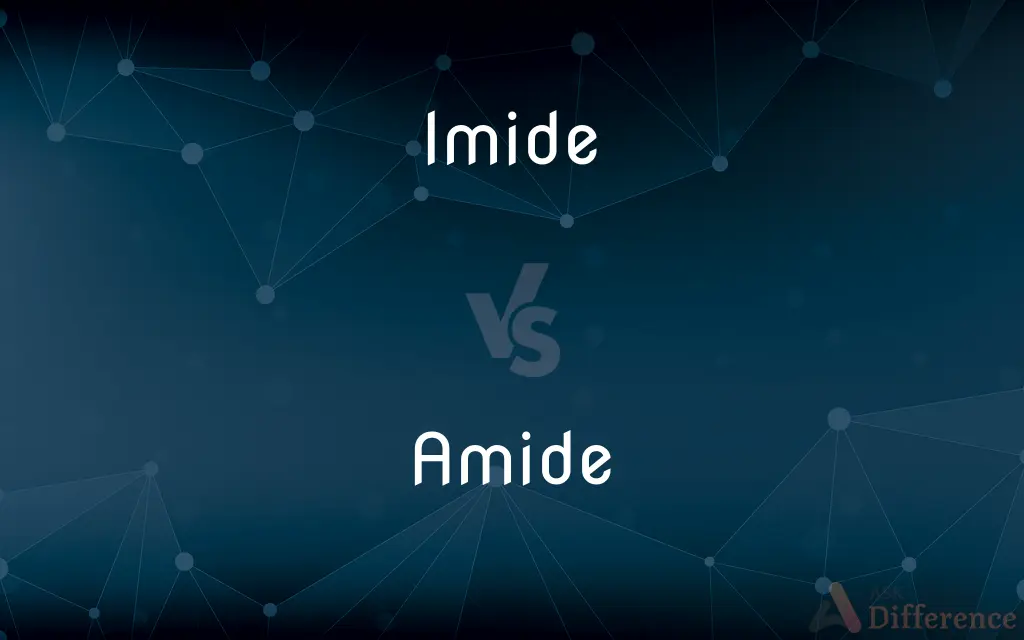Imide vs. Amide — What's the Difference?
Edited by Tayyaba Rehman — By Fiza Rafique — Updated on November 1, 2023
Imides are organic compounds with two acyl groups bound to nitrogen, whereas amides have a single acyl group attached to nitrogen.

Difference Between Imide and Amide
Table of Contents
ADVERTISEMENT
Key Differences
An imide is a compound with two acyl groups attached to a single nitrogen atom. Amides are characterized by the presence of a carbonyl group (C=O) linked to a nitrogen atom which in turn may be connected to hydrogen or an alkyl or aryl group.
Imides are typically derived from dicarboxylic acids, where two carboxylic groups on the same molecule react with an amine. Amides, on the other hand, generally result from the reaction of a carboxylic acid with an amine or ammonia.
The structure of an imide allows for resonance that lends the compound some aromatic character, often making them more rigid and heat-resistant. Amides have a resonance structure too, but the presence of only one carbonyl group makes them less rigid compared to imides.
Imides often have higher melting and boiling points than amides due to their more complex structure. Amides are more commonly found in nature, as in proteins where they form the peptide bonds between amino acids.
Comparison Chart
Number of Acyl Groups
Two acyl groups attached to nitrogen
One acyl group attached to nitrogen
ADVERTISEMENT
Derivation
From dicarboxylic acids
From monocarboxylic acids
Presence in Nature
Less common
More common, as in proteins
Chemical Stability
Typically more stable and heat-resistant
Less stable compared to imides
Example Compound
Phthalimide
Acetamide
Compare with Definitions
Imide
A compound with two acyl groups on a nitrogen atom.
Phthalimide is used in the synthesis of pharmaceuticals.
Amide
An organic compound containing a substituent -CONH2.
Benzamide is an amide derived from benzoic acid.
Imide
A chemical with a nitrogen atom double-bonded to two carbonyl groups.
Imides are known for their high melting points.
Amide
A functional group in proteins.
The amide linkage joins amino acids in a protein.
Imide
A derivative of dicarboxylic acids.
The imide bond in the polymer gives it thermal stability.
Amide
A molecule formed from an acid and amine.
Nylon is a polymer made of repeating amide units.
Imide
A functional group in organic chemistry.
The imide group is crucial in the structure of some synthetic rubbers.
Amide
A compound with a carbonyl group bonded to a nitrogen atom.
Acetamide is soluble in water due to its amide bond.
Imide
A class of compounds in organic synthesis.
Imides serve as intermediates in various chemical reactions.
Amide
A class of compounds used in plastic materials.
Polyamides are known for their strength and durability.
Imide
In organic chemistry, an imide is a functional group consisting of two acyl groups bound to nitrogen. The compounds are structurally related to acid anhydrides, although imides are more resistant toward hydrolysis.
Amide
In organic chemistry, an amide ( or or (listen), also known as an organic amide or a carboxamide, is a compound with the general formula RC(=O)NR′R″, where R, R', and R″ represent organic groups or hydrogen atoms. The amide group is called a peptide bond when it is part of the main chain of a protein, and an isopeptide bond when it occurs in a side chain, such as in the amino acids asparagine and glutamine.
Imide
An acidic organic compound containing two carbonyl groups bonded to ammonia or to a primary amine.
Amide
An organic compound containing the group —C(O)NH₂, derived from ammonia by replacement of a hydrogen atom by an acyl group.
Imide
A strongly basic anion, NH2-, or a salt containing it.
Amide
An organic compound, such as acetamide, containing the CONH2 group.
Imide
(organic chemistry) a form of amide in which the nitrogen atom is attached to two carbonyl groups - R1CONHCOR2
Amide
The anion of ammonia, NH2- or a compound containing this anion, such as sodium amide, NaNH2.
Imide
A compound with, or derivative of, the imido group; specif., a compound of one or more acid radicals with the imido group, or with a monamine; hence, also, a derivative of ammonia, in which two atoms of hydrogen have been replaced by divalent basic or acid radicals; - frequently used as a combining form; as, succinimide.
Amide
(organic chemistry) Any derivative of an oxoacid in which the hydroxyl group has been replaced with an amino or substituted amino group; especially such derivatives of a carboxylic acid, the carboxamides or acid amides
Imide
Any of a class of organic compounds that contain the divalent radical -CONHCO-
Amide
(inorganic chemistry) Any ionic derivative of ammonia in which a hydrogen atom has been replaced with a metal cation (R-NH- or R2N-) Category:en:Nitrogen
Amide
A compound formed by the union of amidogen with an acid element or radical. It may also be regarded as ammonia in which one or more hydrogen atoms have been replaced by an acid atom or radical.
Amide
Any organic compound containing the group -CONH2
Common Curiosities
Can both imides and amides form hydrogen bonds?
Yes, both can form hydrogen bonds, but the bonding patterns differ due to their structures.
Are imides more stable than amides?
Generally, imides are more thermally stable than amides due to their structural rigidity.
Is the synthesis of imides more complex than amides?
Synthesizing imides can be more complex due to the need for dicarboxylic acid precursors.
Are polyamides used in textiles?
Yes, polyamides, like nylon, are widely used in textile manufacturing.
Are amides commonly found in drugs?
Yes, amides are prevalent in pharmaceutical compounds due to their bioactivity.
Are imides acidic or basic?
Imides are typically more acidic due to the electron-withdrawing effect of the two carbonyl groups.
Is it possible to create imides from amides?
Yes, imides can be synthesized from amides under certain conditions, such as through cyclization reactions.
Do both imides and amides have resonance structures?
Yes, both exhibit resonance, which contributes to their stability and reactivity.
Can amides be converted into amines?
Yes, amides can be reduced to amines in a process known as amide reduction.
Can amides be synthesized directly from carboxylic acids?
Yes, amides can be formed by reacting carboxylic acids with amines or ammonia.
Do imides have higher melting points than amides?
Yes, imides often have higher melting points due to their rigid structure and strong intermolecular forces.
Can both imides and amides act as ligands in coordination chemistry?
Yes, both can coordinate to metals, but imides are less common as ligands.
Do amides or imides have a higher reactivity?
Amides are typically more reactive than imides in nucleophilic acyl substitution reactions.
Are imides soluble in water?
Imides are generally less soluble in water compared to amides due to their reduced polarity.
Are both imides and amides present in biological systems?
Amides are common in biology, particularly in proteins, while imides are less common.
Share Your Discovery

Previous Comparison
Bishop vs. Archbishop
Next Comparison
Gargle vs. GurgleAuthor Spotlight
Written by
Fiza RafiqueFiza Rafique is a skilled content writer at AskDifference.com, where she meticulously refines and enhances written pieces. Drawing from her vast editorial expertise, Fiza ensures clarity, accuracy, and precision in every article. Passionate about language, she continually seeks to elevate the quality of content for readers worldwide.
Edited by
Tayyaba RehmanTayyaba Rehman is a distinguished writer, currently serving as a primary contributor to askdifference.com. As a researcher in semantics and etymology, Tayyaba's passion for the complexity of languages and their distinctions has found a perfect home on the platform. Tayyaba delves into the intricacies of language, distinguishing between commonly confused words and phrases, thereby providing clarity for readers worldwide.
















































